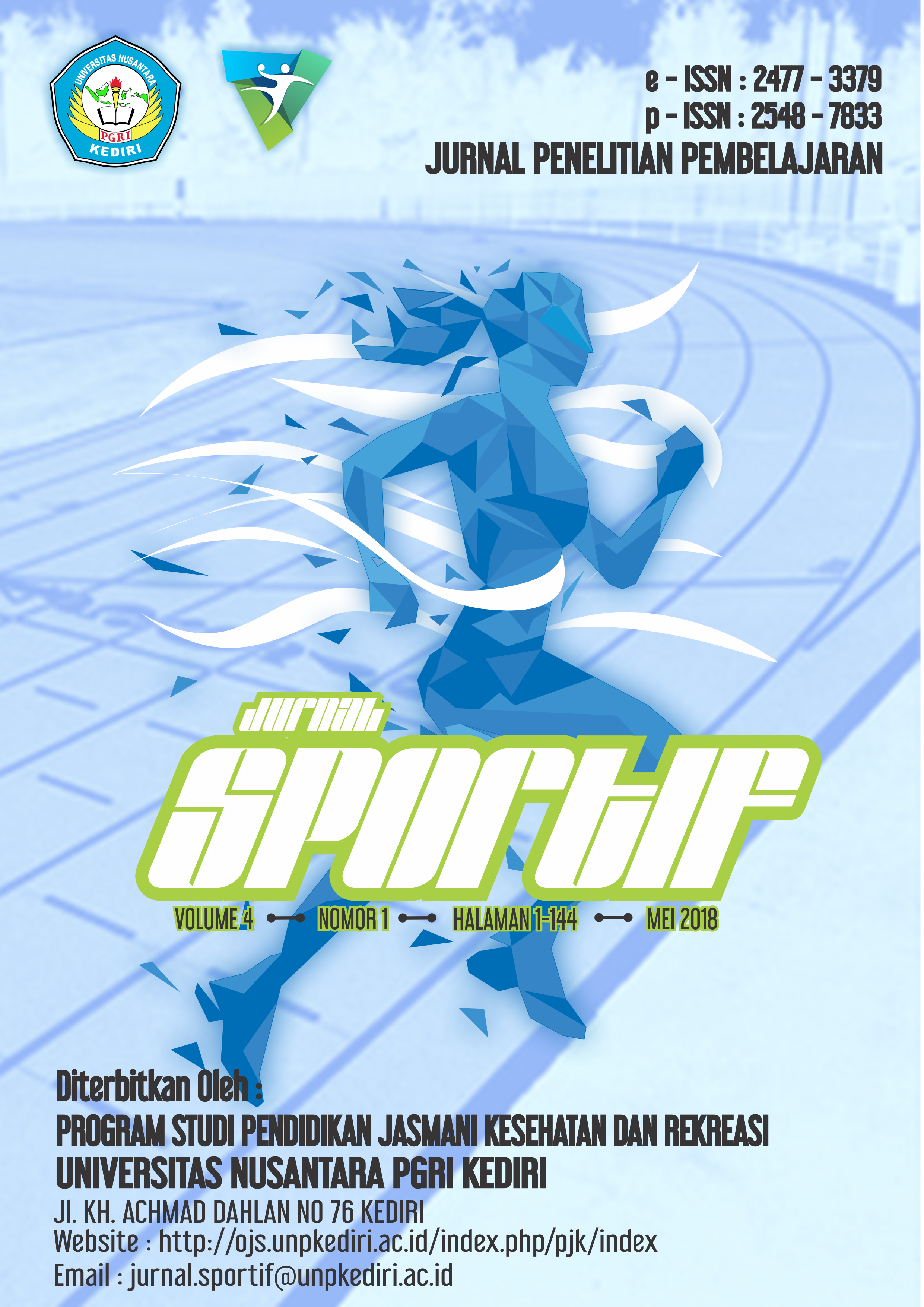Abstract
Tujuan penelitian ini adalah untuk meningkatkan performa atlet bolavoli dan bola basket dengan metode latihan plyometric front cone hops dan plyometric counter movement jump. Tiga puluh siswa yang terpilih sesuai kriteria akan dilakukan pretest untuk menentukan pembagian kelompok plyometric front cone hops, plyometric counter movement jump atau kelompok kontrol. Back leg dynamometer untuk mengukur tingkat kekuatan otot tungkai dan jump MD untuk mengukur tingkat power otot tungkai. Akan diberikan latihan selama 6 minggu untuk masing-masing kelompok dan 3 kali perlakuan dalam seminggu. Hasil uji paired sample t-test menunjukkan metode latihan plyometric front cone hops menunjukkan pengaruh yang signifikan pada variabel kekuatan dan power otot tungkai, kelompok plyometric counter movement jump menunjukkan pengaruh yang signifikan pada variabel kekuatan otot tungkai. Dapat disimpulkan bahwa dari metode latihan plyometric front cone hops dan plyometric counter movement jump lebih efektif untuk peningkatan dua komponen kondisi fisik kekuatan dan power otot tungkai.
References
Bompa, T., & Buzzichelli, C. (2015). Periodization Training for Sports-3rd Edition. Retrieved from https://books.google.com/books?id=Zb7GoAEACAAJ&pgis=1.
Bompa, T.O and Haff, G.G. (2009). Periodezation Theory and Methodology of Training. New York: Human Kinetics.
Candra, A. (2016). Studi Tentang Kemampuan Lompat Tegak Siswa Sekolah Dasar Negeri Berdasarkan Perbedaan Geografis Sebagai Identifikasi Bakat Olahraga. Jurnal SPORTIF : Jurnal Penelitian Pembelajaran, 2(2), 1-14. Retrieved from http://ojs.unpkediri.ac.id/index.php/pjk/article/view/511.
Dinata, Y. L., Sutardji, S., & Waluyo, M. (2013). Perbedaan Pengaruh Latihan Front Cone Hops dan Latihan Zig-Zag Drill Terhadap Peningkatan Power Otot Tungkai. Journal of Sport Sciences and Fitness, 2(1), 24-32.
Johnson, P., & Bujjibabu, M. (2012). Effect of Plyometric and Speed Agility and Quickness (SAQ) on Speed and Agility of Male Football Palyers. Asian Journal of Physical Education and Computer Science in Sports, 7(1), 26-30.
Mahardika, I Made Sriundy. (2010). Pengantar Evaluasi Pengajaran. Surabaya : Unesa University Press.
Mahardika, I Made Sriundy. (2015). Metodologi Penelitian. Surabaya : Unesa University Press.
Maksum, Ali. (2012). Metodologi Pendidikan. Surabaya: Unesa University Press.
Miller, M. G., Herniman, J. J., Ricard, M. D., Cheatham, C. C., & Michael, T. J. (2006). The Effects of a 6-Week Plyometric Training Program on Agility. Journal of Sport Science and Medicine, 5(3), 459-465.
Sulistyo, Y. W. (2016). Pengaruh Latihan Plyometric Front Cone Hops Dan Plyometric Lateral Cone Hops Terhadap Peningkatan Daya Ledak Otot Tungkai Dan Kelincahan. Bravo's Jurnal, 4(3), 142-155.
Authors who publish with this journal agree to the following terms:
- Copyright on any article is retained by the author(s).
- The author grants the journal, the right of first publication with the work simultaneously licensed under a Creative Commons Attribution License that allows others to share the work with an acknowledgment of the work’s authorship and initial publication in this journal.
- Authors are able to enter into separate, additional contractual arrangements for the non-exclusive distribution of the journal’s published version of the work (e.g., post it to an institutional repository or publish it in a book), with an acknowledgment of its initial publication in this journal.
- Authors are permitted and encouraged to post their work online (e.g., in institutional repositories or on their website) prior to and during the submission process, as it can lead to productive exchanges, as well as earlier and greater citation of published work.
- The article and any associated published material is distributed under the Creative Commons Attribution-ShareAlike 4.0 International License





